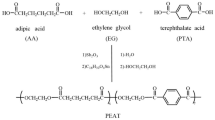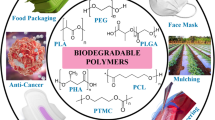Abstract
The bulk ring-opening polymerization (ROP) of ɛ-caprolactone (ɛ-CL) by various phosphoric acids using phenylmethanol as the initiator was conducted. 1,1′-bi-2-Naphthol (BINOL)-based phosphoric acid was found to be an effective organocatalyst for ROP leading to polyesters at 90°C. The overall conversion to poly(ɛ-caprolactone) was more than 96% and poly(ɛ-caprolactone) with M w of 8400 and polydispersity index of 1.13 was obtained. 1H NMR spectra of oligomers demonstrated the quantitative incorporation of the protic initiator in the polymer chains and showed that transesterification reactions did not occur to a significant extent. The controlled polymerization was indicated by the linear relationships between the number-average molar mass and monomer conversion or monomer-to-initiator ratio. In addition, the present protocol provided an easy-to-handle, inexpensive and environmentally benign entry for the synthesis of biodegradable materials as well as polyesters for biomedical applications.
Similar content being viewed by others
References
Vion JM, Jerome R, Teyssié P, Aubin M, Pruďhomme RE. Synthesis, characterization, and miscibility of caprolactone random copolymers. Macromolecules, 1986, 19: 1828–1838
Chielleni E, Solaro R. Biodegradable polymeric materials. Adv Mater, 1996, 8: 305–313
Fujisato T, Ikada Y. New cartilage formation in vivo using chondrocytes seeded on poly(L-lactide). Macromol Symp, 1996, 103: 73–83
Drumright RE, Gruber PR, Henton DE. Polylactic acid technology. Adv Mater, 2000, 12: 1841–1846
Albertsson AC, Varma IK. Recent developments in ring opening polymerization of lactones for biomedical applications. Biomacromolecules, 2003, 4: 1466–1486
Dechy-Cabaret O, Martin-Vaca B, Bourissou D. Controlled ring-opening polymerization of lactide and glycolide. Chem Rev, 2004, 104: 6147–6176
Kamber NE, Jeong W, Waymouth RM, Pratt RC, Lohmeijer BGG, Hedrick JL. Organocatalytic ring-opening polymerization. Chem Rev, 2007, 107: 5813–5840
Dove AP. Controlled ring-opening polymerisation of cyclic esters: polymer blocks in self-assembled nanostructures. Chem Commun, 2008, 6446–6470
Dubois P, Coulembier O, Raquez JM, Eds. Handbook of Ring-Opening Polymerization. Weinheim: Wiley-VCH, 2009
Domínguez de María P. Minimal hydrolases: Organocatalytic ring-opening polymerizations catalyzed by naturally occurring carboxylic acids. ChemCatChem, 2010, 2: 487–492
Gross RA, Kumar A, Kalra B. Polymer synthesis by in vitro enzyme catalysis. Chem Rev, 2001, 101: 2097–2124
Nederberg F, Connor EF, Moller M, Glauser T, Hedrick JL. New paradigms for organic catalysts: The first organocatalytic living polymerization. Angew Chem Int Ed, 2001, 40: 2712–2715
Connor EF, Nyce GW, Myers M, Mock A, Hedrick JL. First example of N-heterocyclic carbenes as catalysts for living polymerization: Organocatalytic ring-opening polymerization of cyclic esters. J Am Chem Soc, 2002, 124: 914–915
Coulembier O, Lohmeijer BGG, Dove AP, Pratt RC, Mespouille L, Culkin DA, Benight SJ, Dubois P, Waymouth RM, Hedrick JL. Alcohol Adducts of N-heterocyclic carbenes: Latent catalysts of the thermally-controlled living polymerization of cyclic esters. Macromolecules, 2006, 39: 5617–5628
Jeong W, Hedrick JL, Waymouth RM. Organic spirocyclic initiators for the ring-expansion polymerization of β-lactones. J Am Chem Soc, 2007, 129: 8414–8415
Kamber NE, Jeong W, Gonzalez S, Hedrick JL, Waymouth RM. N-Heterocyclic carbenes for the organocatalytic ring-opening polymerization of ɛ-caprolactone. Macromolecules, 2009, 42: 1634–1639
Myers M, Connor EF, Glauser T, Mock A, Nyce G, Hedrick JL. Phosphines: Nucleophilic organic catalysts for the controlled ring-opening polymerization of lactides. J Polym Sci Polym Chem Ed, 2002, 40: 844–851
Coulembier O, Sanders DP, Nelson A, Hollenbeck AN, Horn HW, Rice JE, Fujiwara M, Dubois P, Hedrick JL. Hydrogen-bonding catalysts based on fluorinated alcohol derivatives for living polymerization. Angew Chem Int Ed, 2009, 48: 5170–5173
Kricheldorf HR, Kreiser I. Polylactones, 11. Cationic copolymerization of glycolide with L,L-dilactide. Makromol Chem, 1987, 188: 1861–1873
Sanda F, Sanada H, Shibasaki Y, Endo T. Star polymer synthesis from ɛ-caprolactone utilizing polyol/protonic acid initiator. Macromolecules, 2002, 35: 680–683
Lou X, Detrembleur C, JérΩe R. Living cationic polymerization of δ-valerolactone and synthesis of high molecular weight homopolymer and asymmetric telechelic and block copolymer. Macromolecules, 2002, 35: 1190–1195
Persson PV, Schröer J, Wickholm K, Hedenström E, Iversen T. Selective organocatalytic ring-opening polymerization: A versatile route to carbohydrate-functionalized poly(ɛ-caprolactones). Macromolecules, 2004, 37: 5889–5893
Gazeau-Bureau S, Delcroix D, Martin-Vaca B, Bourissou D, Navarro C, Magnet S. Organo-catalyzed ring-opening of ɛ-caprolactone: Methanesulfonic acid competes with trifluoromethanesulfonic acid. Macromolecules, 2008, 41: 3782–3784
Makiguchi K, Satoh T, Kakuchi T. Diphenyl phosphate as an efficient cationic organocatalyst for controlled/living ring-opening polymerization of δ-valerolactone and ɛ-caprolactone. Macromolecules, 2011, 44: 1999–2005
Oledzka E, Narine SS. Organic acids catalyzed polymerization of ɛ-caprolactone: Synthesis and characterization. J Appl Polym Sci, 2011, 119: 1873–1882
Bourissou D, Martin-Vaca B, Dumitrescu A, Graullier M, Lacombe F. Controlled cationic polymerization of lactide. Macromolecules, 2005, 38: 9993–9998
Kakuchi R, Tsuji Y, Chiba K, Fuchise K, Sakai R, Satoh T, Kakuchi T. Controlled/living ring-opening polymerization of δ-valerolactone using triflylimide as an efficient cationic organocatalyst. Macromolecules, 2010, 43: 7090–7094
Koeller S, Kadota J, Peruch F, Deffieux A, Pinaud N, Pianet I, Massip S, Léger JM, Desvergn JP. (Thio)amidoindoles and (thio)amidobenzimidazoles: An investigation of their hydrogen-onding and organocatalytic properties in the ring-opening polymerization of lactide. Chem Eur J, 2010, 16: 4196–4205
Zhang L, Nederberg F, Messman JM, Pratt RC, Hedrick JL, Wade CG. Organocatalytic stereoselective ring-opening polymerization of lactide with dimeric phosphazene bases. J Am Chem Soc, 2007, 129: 12610–12611
Zhang L, Nederberg F, Pratt RC, Waymouth RM, Hedrick JL, Wade CG. Phosphazene bases: A new category of organocatalysts for the living ring-opening polymerization of cyclic esters. Macromolecules, 2007, 40: 4154–4158
Lohmeijer BGG, Pratt RC, Leibfarth F, Logan JW, Long DA, Dove AP, Nederberg F, Choi J, Wade CG, Waymouth RM, Hedrick JL. Guanidine and amidine organocatalysts for ring-opening polymerizion of cyclic esters. Macromolecules, 2006, 39: 8574–8583
Pratt RC, Lohmeijer BGG, Long DA, Waymouth RM, Hedrick JL. Triazabicyclodecene: A simple bifunctional organocatalyst for acyl transfer and ring-opening polymerization of cyclic esters. J Am Chem Soc, 2006, 128: 4556–4557
Sun X, Gao JP, Wang ZY. Bicyclic Guanidinium tetraphenylborate: A photobase generator and a photocatalyst for living anionic ring-opening polymerization and cross-linking of polymeric materials containing ester and hydroxy groups. J Am Chem Soc, 2008, 130: 8130–8131
Dove AP, Pratt RC, Lohmeijer BGG, Waymouth RM, Hedrick JL. Thiourea-based bifunctional organocatalysis: Supramolecular recognition for living polymerization. J Am Chem Soc, 2005, 127: 13798–13799
Pratt RC, Lohmeijer BGG, Long DA, Lundberg PNP, Dove AP, Li H, Wade CG, Waymouth RM, Hedrick JL. Exploration, Optimization, and application of supramolecular thiourea-amine catalysts for the synthesis of lactide (co) polymers. Macromolecules, 2006, 39: 7863–7871
Chuma A, Horn HW, Swope WC, Pratt RC, Zhang L, Lohmeijer BGG, Wade CG, Waymouth RM, Hedrick JL, Rice JE. The reaction mechanism for the organocatalytic ring-opening polymerization of L-lactide using a guanidine-based catalyst: Hydrogen-bonded or covalently bound. J Am Chem Soc, 2008, 130: 6749–6754
Becker JM, Tempelaar S, Stanford MJ, Pounder RJ, Covington JA, Dove AP. Development of amino-oxazoline and amino-thiazoline organic catalysts for the ring-opening polymerization of lactide. Chem Eur J, 2010, 16: 6099–6105
Yamanaka M, Itoh J, Fuchibe K, Akiyama, T. Chiral Brønsted acid catalyzed enantioselective Mannich-type reaction. J Am Chem Soc, 2007, 129: 6756–6764
Sakakura A, Sakuma M, Katsukawa M, Ishihara K. Selective synthesis of cyclic phosphoric acid diesters through oxorhenium(VII)-catalyzed dehydrative condensation of phosphoric acid with alcohols. Heterocycles, 2008, 76: 657–665
Sutherland JD, Weaver GW. Synthesis of bis(glycoaldehyde) phosphodiester and mixed glycoaldehyde-triose phosphodiesters. Tetrahedron Lett, 1994, 35: 9109–9112
Jankowska J, Stawiński J. A facile synthesis of cyclic phosphodiesters. Synthesis, 1984, 408-410
Cremlyn R, Ruddock K, Obisesan O. Derivatives of cyclohexane-1,2-diol-phosphorochloridate and 1-chlor-4,5-benz-2,6-dioxa-phosphorinanone-(3)-1-oxide. Phosph Sulf, 1981, 10: 333–338
Penczek S, Kubisa P, Szymanski R. One the diagnostic criteria of the livingness of polymerizations. Makromol Chem Rapid Commun, 1991, 12: 77–80
Simón L, Goodman JM. Theoretical study of the mechanism of Hantzsch ester hydrogenation of imines catalyzed by chiral BINOL-phosphoric acids. J Am Chem Soc, 2008, 130: 8741–8747
Li N, Chen XH, Song J, Luo SW, Fan W, Gong LZ. Highly enantioselective organocatalytic Biginelli and Biginelli-like condensations: Reversal of the stereochemistry by tuning the 3,3′-disubstituents of phosphoric acids. J Am Chem Soc, 2009, 131: 15301–15310
Susperregui N, Delcroix D, Martin-Vaca B, Bourissou D, Maron L. Ring-opening polymerization of ɛ-caprolactone catalyzed by sulfonic acids: Computational evidence for bifunctional activation. J Org Chem, 2010, 75: 6581–6587
Author information
Authors and Affiliations
Corresponding author
Rights and permissions
About this article
Cite this article
Chen, C., Xu, R. & Li, B. Controlled/living ring-opening polymerization of ɛ-caprolactone catalyzed by phosphoric acid. Sci. China Chem. 55, 1257–1262 (2012). https://doi.org/10.1007/s11426-012-4586-x
Received:
Accepted:
Published:
Issue Date:
DOI: https://doi.org/10.1007/s11426-012-4586-x




